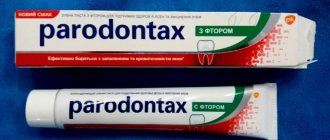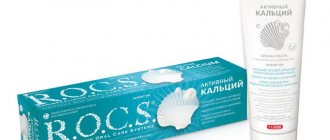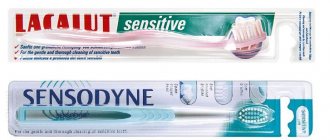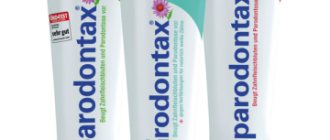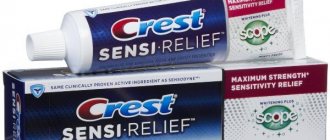Author of the article:
Soldatova Lyudmila Nikolaevna
Candidate of Medical Sciences, Professor of the Department of Clinical Dentistry of the St. Petersburg Medical and Social Institute, Chief Physician of the Alfa-Dent Dental Clinic, St. Petersburg
For many years, every second person in the street was convinced that a good toothpaste must certainly contain fluoride. Our grandparents stubbornly insisted on the importance of this element. But is fluoride really necessary in toothpaste, or does the harm of this microelement still outweigh its benefits? Let's try to figure it out.
The history of fluoride in toothpastes
Fluoride was first used in toothpastes more than 100 years ago, in 1914 in the USA. At the beginning of the 20th century, scientists found that this element is an excellent protection against caries and its use reduces the rate of tooth decay by an average of 30-45%. Under the influence of fluorine, enamel became resistant to acids and more durable.
Why is fluoride needed in toothpaste?
Surprisingly, the same element can be both healing and destructive to the body. And fluoride is just that: the substance can both restore and strengthen tooth enamel, and cause irreparable harm to it. It is thanks to fluoride that the strength of bone tissue in the body is maintained; this element plays a key role for the health of hair, nails and teeth. Fluoride is very important in the growth and development of a child: without it, his skeleton does not develop normally.
In addition, fluorine has a beneficial effect on metabolism: without this element, the body cannot remove heavy metals. The substance also helps absorb iron and supports immunity.
When there is a lack of fluoride in the body, bones and teeth are the first to suffer. Bones bend, become brittle and brittle, and in the event of a fracture they heal very slowly. With a lack of fluoride, the enamel gradually becomes thinner, it is increasingly affected by plaque bacteria, and caries develops faster and faster.
In fact, it is not difficult to provide the body with its daily requirement of fluoride. Products high in this substance include:
- a variety of fruits, such as grapefruits and apples;
- nuts;
- dairy products;
- various types of meat (especially liver);
- various vegetables - pumpkin, spinach, potatoes;
- buckwheat and oatmeal porridge;
- honey;
- any types of tea.
By drinking enough water per day and eating right, you can provide yourself with fluoride. Therefore, the need for toothpastes with fluoride should only be determined by a dentist. As a rule, fluoride products are prescribed to smokers and people who abuse coffee.
A little history
The first statements that fluoride is good for teeth, as well as that it should be added to drinking water to prevent dental disease, were made by a certain doctor - Gerald Cox (Melon Institute, Pittsburgh, Canada)
Francis Freri, in turn, was very concerned about the negative impact of fluorides on the health of plant workers, as well as the pollution of the air and nature in the vicinity of the aluminum smelters.
It should be noted that the Melon Institute was the main defender of the metal processing industry and, of course, for all its large companies. It is no coincidence that it was from the researchers of this institute that this proposal came.
At that time, from the mid-50s to the mid-60s, there were so many lawsuits related to health harm caused by fluoride alone (than 20 other pollutants combined) that companies urgently needed protection from the enormous amount lawsuits. And a solution to the problem was found. A theory was invented that was supposedly based on actual research that fluoride was good for your health!
One of the defenders of the theory of fluoridation was one of the most influential and famous physicians , with unquestioned authority among those in power - Harold Hodge. Hodge was responsible for numerous works in support of the water fluoridation program and its implementation by 1957.
Today it became known that it was Hodge who was one of the organizers of research and experiments on the effects of radiation on human health after inoculation with plutonium.
So what's the connection?
The most direct one. Harold Hodge served as chief toxicologist on the Manhattan Project.
The project was launched with the goal of developing an atomic bomb, which was subsequently dropped on Jeroshima and Nagasaki. Hodge conducted research on the toxicity of various chemical reagents that were components of the atomic bomb, and the main problem was precisely fluorides; they were used in incredible quantities in the creation of atomic weapons.
In the discovered documents, the book's author, Bryson, saw records that Hodge was given an assignment to provide information to help the government and army defend against lawsuits that were related to personal injury. All information used against the army must be destroyed.
If the dangers of water fluoridation were recognized, then absolutely all organizations that worked with fluoride would be subject to countless lawsuits. Even the US government and military, including the Nuclear Energy Commission. Naturally, Harold Hodge would in no way frame these influential organizations.
Dr. Keyhoe, a famous physician and promoter of the theory of fluoridation , has published large scientific works on the benefits of fluorides.
These works were sponsored by:
Aluminum Company of America (ALCOA), Aluminum Company of Canada, DuPont, Fuel and Lubricants Research Institute of America, Reynolds Metals, United Steel, Kaiser Aluminum, National Institute of Dental Research (NIDR).
In Dr. Keyhoe's personal notes, you can find information about cooperation with the Fluoride Legality Committee, to which Dr. Keyhoe provided materials to defend against fluoride-related lawsuits from corporate clients (see list above).
In addition, none other than Sigmund Freud’s nephew, PR’s father, Edward Bernays, helped sell fluorides to the entire nation.
Edward Bernays was a true professional in the field of creating attractive images for harmful products. Edward was a good psychologist, and conducted research on managing the human mind, and more precisely, managing society. He even published the book “Propaganda”.
While promoting fluoridation, Bernays also took part in promoting cigarettes . Invited to NIIOS to help promote fluoride to the nation, Bernays worked to convince dentists that fluoride was good for teeth. Then the already treated dentists themselves “sold” fluoride to everyone else.
For decades, propaganda in favor of fluoride has been carried out among the population . Scientists who openly stated that fluoride was harmful to the human body were persecuted, ridiculed in the press, or fired from their jobs.
Only today scientists have the opportunity to publish research results that talk about the dangers of fluoride, even in doses allowed by standards.
Widely advertised toothpastes (“Blend-a-med”, “Colgate”, “Aquafresh”, etc.) contain fluoride in fairly large quantities. People buy these toothpastes because of repeated lies in advertising.
So what should we do now?
First, look at this issue with different eyes. Following common sense, we must understand that we should not take (especially regularly) any substances if we do not understand what the substance is.
Even if slight doubts creep in that fluoride can be harmful, it means there is no point in using it. In our case, numerous materials convince us that it is better to abandon it.
Tips from dentists for “fluoride-free” caries prevention:
- The less often we eat food rich in white sugar, the less acid the bacteria will produce.
- It is advisable to consume sugar only in whole foods - nuts, fruits, dried fruits. Even more harmful than white sugar is a genetically modified sweetener (aspartame).
- Reduce the amount of time sugar remains in your mouth. After eating a meal rich in sugar, you should brush your teeth or rinse your mouth.
- It is also harmful to suck sweets in the mouth and drink sugary drinks for a long time. If you drink sweet water, you should immediately brush your teeth.
- It is necessary to brush your teeth thoroughly and often, both with floss and a brush.
Additional Information:
Countries that have banned water fluoridation:
Germany, Austria, Switzerland, Holland, France, Belgium, China, Czech Republic, Denmark, Finland, Hungary, India, Israel, Japan, Luxembourg, Norway, Scotland, North. Ireland, Sweden.
The pineal gland is the first to be hit by fluoride.
It was not until the early 1990s that research began to be conducted on the effects of fluoride on the pineal gland. The pineal gland, or pineal gland, is a small gland that is located between the two hemispheres of the brain.
The pineal gland regulates the release of melatonin, the “youth” hormone , which in turn helps regulate the achievement of puberty . Melatonin is produced by the pineal gland from serotonin, a substance that scientists suggest affects human mental function.
It is also very important that the pineal gland is responsible for immunity , and when it functions normally, it protects the body from the harmful effects of free radicals on the brain.
The initiator of this study, doctor Jennifer Luke (University of Surrey in England), proved that the pineal gland is the first to be affected by fluoride. According to research, excessive amounts of this element in the pineal gland lead to serious dysfunctions and provoke early puberty, and the body’s ability to fight free radicals also decreases.
Research shows the dangerous effects of fluoride on the fetus during pregnancy. Fluoride can cause genetic changes in the fetus, thereby increasing the risk of cancer. Recent studies have shown that fluoride can cause bone cancer.
The worst thing is that almost no one pays attention to these facts. Think about what would happen to the industry if everyone knew about the toxicity of fluoride and its harmful effects on our health!
Fluoride compounds have the most significant effect on the thyroid gland
Research data from scientists shows that thyroid diseases began to increase just at the time when the benefits of fluoride began to be promoted . It is known that the thyroid gland in the body is responsible for many processes related to metabolism.
Violation of its work leads to serious consequences for a person, one of which is obesity . It is no coincidence that the popularization of fluoride in the United States has led to the country's population becoming fatter. Scientists have tracked the relationship between these processes.
Excess fluoride in the body can destroy bones, teeth and the pineal gland
Long-term use of fluoride can lead to genetic damage to DNA, cancer, obesity, low IQ, lethargy, Alzheimer's disease and many other diseases.
Almost all toothpastes contain fluoride. Since childhood, it has been drilled into our memory that we need to brush our teeth twice a day.
The effect of fluoride on the thyroid gland is not all.
Fluorine, actively reacting with aluminum , which is widely used in the manufacture of tableware, forms aluminum fluoride, which can overcome the blood-brain barrier.
The blood-brain barrier protects our brain from harmful substances. Aluminum fluoride penetrates through it and is deposited in nerve cells. The consequences of this compound for the brain can be catastrophic.
This includes dementia and a number of mental and nervous disorders. Studies by some independent scientists have shown that cases of Alzheimer's disease have increased significantly since the popularization of fluoride. Therefore, it is not surprising that the United States is one of the leaders in the incidence of Alzheimer's disease, since fluoridation is used especially widely in this country.
From the Chemicals Handbook:
Sodium fluoride is a synthetic component in the form of white crystals. It is used as an antibacterial agent for oral care. The active part of the molecule is the fluoride ion. Fluoride reduces the bacteria's ability to produce acid, and it also remineralizes the area of the teeth that have been exposed to the acid produced by the bacteria. ABOUT.
May be fatal if inhaled or if swallowed. The main symptoms of poisoning are diarrhea and weakness, nausea, vomiting. Next comes damage to the cardiovascular and central nervous systems, which leads to death.
It also affects the kidneys, respiratory system, central nervous system, heart, bones, and circulatory system. Causes irritation to eyes, respiratory tract and skin. Irritation does not occur immediately.
Causes severe irritation to the respiratory tract if inhaled. The first symptoms are difficulty breathing, cough, sore throat.
Toxic if taken orally! Causes stomach pain, nausea, vomiting, diarrhea and drooling. Difficulty breathing, weakness, trembling, heart attack, then convulsions and coma. It affects the kidneys and brain. Death occurs due to paralysis of the respiratory tract. The lethal dose is about 5-10 grams.
Causes irritation upon contact with skin, pain and redness.
In case of eye contact, ranges from irritation to serious eye damage.
Long-term exposure to fluoride can damage bones (osteosclerosis), as well as fluorosis. Fluorosis leads to bone fragility, weight loss, anemia, hardening (calcification) of ligaments, deterioration of general condition and joint stiffness.
People with diabetes and kidney failure are especially susceptible to the effects of fluoride.
So why is excess fluoride dangerous?
The addition of fluoride to municipal waters, as well as other methods of its use, cause concern among people.
In a number of countries (not Russia), synthetic fluoride compounds are added to water and also used in drinks, hygiene and food products, for example, toothpastes.
The most commonly used waste products from the nuclear, aluminum and phosphate (approval) industries are:
(sodium silicofluoride) - sodium fluorosilicate
(sodium fluoride) - sodium fluoride
(fluorosilicate acid) - fluorosilicic acid
Fluoride is not quickly eliminated from the body; it accumulates in bones and teeth over time.
Recently it became known that it accumulates even more intensely in the pineal gland, which is located in the middle of the brain.
Dental fluorosis, causing serious damage to teeth, with daily use of fluoride toothpastes has already been documented.
Despite this, today there is official propaganda about the use of fluoride for the prevention of caries. The fact that fluoride does more harm than good continues to be ignored.
Pros of fluoride toothpastes
Many people specifically choose hygiene products with fluoride to strengthen their teeth and prevent the development of caries. Indeed, in some cases, this element protects the enamel from the action of harmful bacteria and strengthens it. Under the influence of fluoride, less acid is released, which affects the enamel. Therefore, anti-caries toothpastes often contain fluoride.
The main benefits of fluoride toothpastes include:
- antiseptic effect;
- improvement of metabolism;
- improvement of the remineralizing effect of saliva;
- stimulation of the salivary gland;
- inhibition of the transformation of soft plaque into tartar.
Harm of toothpastes with fluoride
Unfortunately, many of us forget that toothpaste is not the only source of fluoride. This element is found in many foods and even in ordinary tap water.
Before you buy even the best toothpaste with fluoride, it is important to understand your need for this element: its daily intake should not exceed three milligrams. In order to get this dose, it is enough to drink two liters of water a day.
For a person who eats right and drinks enough water, it is not at all necessary, and often even harmful, to use toothpastes with fluoride. The fact is that this element in excess amounts is toxic to the body. The substance accumulates in tissues, including tooth enamel. If too much fluoride accumulates in it, fluorosis appears, the process of destruction of enamel.
Fluorosis is very easy to recognize. The disease manifests itself as white spots on the surfaces of the teeth. These spots grow quickly, turn yellow and begin to corrode the enamel. In case of fluorosis, it is important to start treatment as soon as possible - remineralizing therapy, photophoresis or the use of special applications.
Often, teeth with fluorosis require additional whitening, because it is almost impossible to cope with such a problem with the help of professional cleaning.
Fluorine is the 9th element of the periodic table
Fluorine is a chemical element from the halogen group. Actively contacts with other substances. As a result, bright reactions appear: combustion, explosion, boiling. Research by dentists has revealed the presence of fluoride at approximately 0.02% in tooth enamel. The population of regions where the water contains insufficient amounts of fluoride is more susceptible to caries. At the same time, its excess is manifested by darkening of the teeth and the presence of white spots on them (fluorosis). Over time, the enamel begins to gradually deteriorate.
Indications for the use of fluoride pastes
Of course, in some cases, toothpastes with fluoride will be useful to patients, but, as we have already said, only a dentist should prescribe them. The specialist will assess the condition of the enamel and oral cavity, and then determine whether the teeth have enough fluoride and what kind of toothpaste they need.
Therapeutic toothpastes with calcium and fluoride are indicated for use if the patient has:
- signs of dental demineralization;
- poor enamel resistance to acids;
- fragility of teeth, tendency to chip;
- minor signs of caries.
The fluorides contained in such toothpastes create a thin protective layer on the crowns. All substances hazardous to enamel do not penetrate it and their negative impact is reduced several times. Incoming fluoride, when it is deficient in the body, slows down the proliferation of bacteria and, accordingly, the development of caries. The likelihood of gum inflammation is also reduced.
Why is this component so important for dental health - the benefits of the substance
The content of this element in oral care products protects against caries, makes enamel stronger, effectively removes plaque and fights pathogenic microflora. Let's take a closer look at the undoubted advantages of this component.
Prevention of caries
The enamel is constantly exposed to aggressive acids that are released with saliva. Food remains and other external factors lead to the formation of plaque, which gradually transforms into hard dental deposits, leading to the destruction of the enamel layer. As a result, a white spot first appears, which darkens and turns into a carious cavity.
Fluorine penetrates the crystal lattice of enamel, strengthens it and increases resistance to pathogenic microorganisms. It provides prevention of caries and prevents its further development, even if the disease is already at the white spot stage.
Decalcification protection
The substance promotes a process called “remyelination” - the transition of ions from the blood to the body’s tissues. Saliva, which is produced during food intake, leads to the opposite effect, that is, loss of calcium from dental tissues. When calcium and fluoride ions enter the oral cavity, they penetrate the crystal lattice of the enamel, strengthening it and preventing the destruction of hard tissues under the influence of saliva.
Strengthening enamel
The basis of enamel is calcium hydroxyapatite. By interacting with the microelement in question, this salt is converted into a new substance - fluorine hydroxyapatite. Thus, the microelement in question acts as a calcium protector, protecting it from the aggressive effects of acids in the oral cavity.
Prevention of the growth of pathogenic microflora
Pathogenic microorganisms that form plaque secrete special enzymes necessary for the breakdown of carbohydrates and their absorption. Our substance blocks the production of these enzymes, which prevents the further spread of pathogenic microflora.
This is interesting: Fluoride-free toothpaste: list of products for children and adults
Fluoride works great against plaque
“I have been using fluoride toothpaste for a year now and am very pleased with the results! About six months ago I bought myself an irrigator, so with them, every morning cleaning feels like after professional hygiene at the dentist. I recently had a preventive examination and there were no problems with the enamel. And I myself understand that sensitivity has not appeared, the teeth are white, without spots or irregularities. It seems to me personally that all this hysteria about the harm of such products is greatly exaggerated!”
AlesyaK., Moscow, from correspondence on the woman.ru forum
Stopping the secretion of lactic acid
This microelement blocks excess lactic acid synthesis, thereby effectively suppressing the growth of pathogenic microflora. This acid is produced by microorganisms during their life and reproduction. Products containing this component prevent this process, thereby providing additional protection for the enamel.
Consequences of excess fluoride in the body
Do not forget that fluorine is, first of all, a toxic substance. It is added to toothpastes only in the form of compounds that can release active ions. The pastes contain sodium fluoride, sodium monophosphate, as well as tin and aluminum fluorides, and amino fluoride.
When fluoride enters the body of an adult in excess quantities, the following problems may begin:
- disruption of metabolic processes and, as a result, destruction of bones and teeth;
- disruptions in the functioning of the endocrine system;
- liver and kidney diseases;
- increased blood pressure;
- decreased immunity.
Surprisingly, translated from Greek, the word fluorine means “destroying.” Fluorine compounds in the gaseous state are deadly. And fluorites, often added to toothpastes, are considered one of the most harmful substances for the body.
If you use fluoride paste constantly, without apparent need, the following changes may occur in the oral cavity:
- damage to the enamel, the appearance of stains on it;
- fragility of teeth;
- increased sensitivity of teeth.
Choosing a brush - expert advice
Another mandatory attribute of daily oral care is a brush. Her choice also needs to be taken seriously, and dentists give the following advice on this matter:
- the head should not exceed 3 cm in length,
- it is better to choose models with artificial bristles, since natural ones create favorable conditions for the growth of bacteria,
- The ribbed back surface of the head is designed to clean the tongue - there is no need to additionally purchase a special scraper.
It is important to choose the right toothbrush.
If you have sensitive gums that are prone to inflammation and bleeding, it is better to give preference to a brush with soft bristles. But keep in mind that it will be worse at cleaning the enamel from plaque, so the procedure must be especially intense. Hard brushes are intended to be used according to indications - otherwise they can injure the gums and enamel and do more harm than good.
Sources:
- https://myecotest.com/vred-ftora-v-zubnoy-paste/
- https://Ru-organic.com/info/zubnaya-pasta-s-ftorom.html
- https://asepta.ru/spravochnik/zubi/zubnye-pasty-s-ftorom/
- https://DentConsult.ru/sredstva/ftorsoderzhashie-zubnye-pasty.html
- https://himya.ru/ftoridy.html
- https://FB.ru/article/254057/ftor-v-zubnoy-paste-polza-i-vred-chem-i-kak-pravilno-chistit-zubyi
- https://poleznii-site.ru/dom/byt/vreden-li-ftor-v-zubnoy-paste-ego-rol-v-organizme.html
- https://24stoma.ru/lechebnaya-zubnaya-pasta-ot-kariesa.html
Children's toothpastes with fluoride
Children's toothpastes should absolutely not contain fluoride, despite the fact that this element is necessary for growing organisms. Fluoride is added only to toothpastes for children and adolescents over 5 years of age. The thing is that young organisms perceive various components much more strongly and are many times more susceptible to fluorosis (excess fluoride).
So, now you know the benefits and harms of fluoride in toothpastes. You should not decide on the use of such means on your own. Only an experienced dentist should prescribe pastes with fluoride and calcium.
To avoid the need for medicinal pastes, take good care of your teeth and be attentive to your body. Do not get carried away with coloring products, coffee, tea and sweets. For dental health, the absence of bad habits, proper, balanced nutrition and daily thorough hygiene procedures are important.
An excellent tooth support product is ASEPTA “Remineralization” professional toothpaste with high concentrations of hydroxyapatite and thermal mud. This remedy restores tooth enamel, reduces the sensitivity of teeth and gums and accelerates the regeneration of the oral mucosa.
Why is it dangerous?
- Halogen is harmful to the condition of teeth when the body is oversaturated with it. Teeth become brittle, “spotty,” and darken. Other organs and systems suffer: bones, ligaments, muscles. The ability to learn new material, remember and comprehend is reduced.
- Halogen is very dangerous if inhaled or ingested. Nausea, vomiting, and diarrhea may occur. In the future, damage to the nervous and cardiovascular systems occurs, the kidneys suffer, even death.
- If the substance enters the respiratory tract, sneezing, coughing, and difficulty breathing occur.
- Sodium fluoride in toothpaste is extremely dangerous for people suffering from diabetes and kidney failure. Accumulating in the body, it can seriously aggravate the disease.
- The fluoride content in toothpastes can also negatively affect the functioning of the thyroid gland. The functioning of the immune system decreases, a person becomes susceptible to various diseases.
- The presence of fluoride in toothpaste can become a trigger for the development of cancer. Especially if you have a predisposition to them.
- The production of collagen in body tissues decreases. The skin becomes dehydrated, becomes flabby and pale. A person looks and feels older than his age.
“Toothpastes contain fluoride that far exceeds the concentration found in natural sources.”
Clinical researches
Clinical studies have proven that regular use of professional toothpaste ASEPTA REMINERALIZATION improved the condition of the enamel by 64% and reduced tooth sensitivity by 66% after just 4 weeks.
Sources:
- Report on the determination/confirmation of the preventive properties of personal oral hygiene products “ASEPTA PLUS” Remineralization doctor-researcher A.A. Leontyev, head Department of Preventive Dentistry, Doctor of Medical Sciences, Professor S.B. Ulitovsky First St. Petersburg State Medical University named after. acad. I.P. Pavlova, Department of Preventive Dentistry
- Study of the clinical effectiveness of treatment and prophylactic agents of the Asepta line in the treatment of inflammatory periodontal diseases (A.I. Grudyanov, I.Yu. Aleksandrovskaya, V.Yu. Korzunina) A.I. GRUDYANOV, Doctor of Medical Sciences, Prof., Head of Department I.Yu. ALEXANDROVSKAYA, Ph.D. V.Yu. KORZUNINA, asp. Department of Periodontology, Central Research Institute of Dentistry and Maxillofacial Surgery, Rosmedtekhnologii, Moscow
- Clinical studies of antisensitive toothpaste “Asepta Sensitive” (A.A. Leontyev, O.V. Kalinina, S.B. Ulitovsky) A.A. LEONTIEV, dentist O.V. KALININA, dentist S.B. ULITOVSKY, Doctor of Medical Sciences, Prof. Department of Therapeutic Dentistry, St. Petersburg State Medical University named after. acad. I.P. Pavlova
